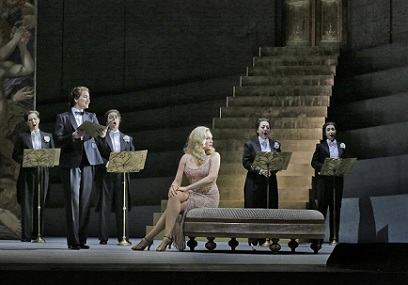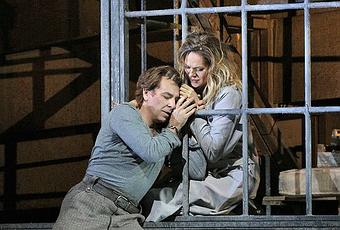
Final Scene, DesGrieux (Roberto Alagno) and Manon dying (Christine Opolais)
Friends and readers,
As a lover of Prevost’s famous story (as written by him), and having been moved by an intelligent and powerful European production of Massenet’s Manon (5 years ago now), Puccini’s Manon Lescaut as produced by the Met was something of a disappointment. It reminded me of an early 19th century French operatic version of Romeo and Juliet Jim, I, and Izzy, saw years ago at Glimmerglass, where until the last act I felt almost nothing and then suddenly at the long death scene where the lover awaken and dying grieve at length I was overcome with emotion at the lyrical beauty, acting, even words (subtitles though they were) of this opera. In this new production at the Met, the very last scene of Manon dying at length in Des Grieux’s arms sent through me waves of identification as I felt them experience her dying, with the music and singing heart-breakingly beautiful as inch-by-inch she despaired and died, and he enacted a deep form of empathy with her.
The whole of this Manon Lescaut exists to get us to this long many phase final scene. Puccini has stripped Prevost’s story of much of its rational or content. All he is interested in are the lovers when they are anguished; how they got there, is irrelevant it seems. Prevost’s original lovers are desperately trying to escape the norms and demands of the ancien regime: Des Grieux’s father wants him to become a priest, and doesn’t care if it would be utterly hypocritical of him. When Des Grieux refuses, the father uses lettres de cachet to imprison him. Prevost’s Manon is much lower in rank than Des Grieux and so unsuitable as far as the father is concerned, first seen in chains, being sent out of France as prisoner. In Massenet Manon is simply lower middle, without dowry, her brother is attempting to force her into a nunnery, but beyond that much of the original 18th century context is kept. In Prevost and Massenet, the two flee together; they are no paragons: he gambles to live, drinks, has had other women, and she deserts him more than for rich old man, but they do want to live lives true to their emotional realities and desires. They fall lower and lower, become thieves, crooks, in and out of trouble with the police, in Prevost finally ending in a desert in Louisiana, looking out on a meaningless horizon (the story is fideist), starved, exhausted, with her falling ill and dying. Massenet has a substitute setting in France for the last gouging into death.
Puccini cut all this out, and we begin with Manon as a beautifully innocent young woman, utterly stereotypical non-entity, Des Grieux, a chivalrous male student (anticipating La Boheme) who fall in love,

though her successful flight from her brother is engineered by Geronte (Brindley Sherratt), a vicious old man who turns up in the first scene (taking the place of Prevost’s father figure). In other words, Puccini robbed the characters of their content, context, complexity, their interest, leaving us with archetypes. The first scene of this production put me to sleep. Everyone was dressed in World War Two clothes and the soldiers were Nazis, but beyond that it looked and felt like some bland cheerful group of tourists at a cafe beneath museum steps.

Only Sherratt’s acting of a seething resentful old man and fine dark voice gave the scene any bite. If Puccini did this because the 19th century audience would not tolerate overt amorality, it didn’t work, as the program notes and wikipedia informed us the opera was thought scandalous and censored.
The production came alive in the second act. Genuinely funny in a self-reflexive way was Eyre’s original way of presenting a now rich and vulgar Manon and her brother, Lescaut (Massimo Cavalletti) as bored silly by the operatic songs and music of her aging and as we have felt mean, spiteful, (and as we discover) vengeful ancient lover-keeper, Geronte (Brindley Sherratt):

When Grieux rushes in and he and Manon become lovers once again,

only to be caught and threatened by said old man, the action on stage was compelling enough. There is even a suddenly evocative song between them. The stage seemed to me modeled on Lulu as there was again a long stairway down with a prison-like door out of which came first the old man, and then a group of Nazi officers who arrested Manon at the orders of her ex-protector. Maybe it was the same set with different accoutrements? (A penny saved is a penny got.) The furniture was all similarly tasteless vulgarly show-offy, though nowhere as graphic or meaningful as in Lulu (which had pictures to go with the setting). Christine Opolais’s dress evoked Marilyn Monroe on a particularly egregiously sexy day.
This use of sets to mirror the later 20th century continued in the third act and last scene. The prison looked like places where people are kept in solitary confinement, not gothic so much as places where senseless injustice is going on. (Welcome to the US or Egypt or a dozen or more other countries in the world, 2016.) Puccini’s Lescaut has tried to bribe a soldier to release Manon to Des Grieux and in this act the soldier fails to help them.

And at this point the opera moved into doing what it was there to do. Our lovers become desperately clinging anguished figures:

They did sing so movingly, and the music began to soar. I recognized in the second act and again here music I’ve heard before. Lescaut is shot (and looks like he is dying), Manon taken aboard a ship for the colonies with other women prisoners (prostitutes, poor women), with Des Grieux succeeding by begging to get the captain to let him come aboard. So now we are with refugees.
And then we are in our last scene, which appears to be a bombed out world. It looks like gigantic pillars of some iron building have fallen this way and that. There is a building still standing where all the glass has been shattered, and our lovers have to stumble their way up and down the columns. Here Des Grieux raises himself to cry out against what is happening (since the empty horizon and desert are gone it cannot be against some Godless wasteland)

He then runs off to find help. She thinks he has deserted her and Opolais’s acting and singing were unbearably despairing, plangent. I lost it and began to cry. And when he returned, we were set for our Romeo and Juliet close.
The reviews of the production have not been generous. Justin Davidson of the Vulture saw the sets as preposterous, making no sense and the second transposition from Puccini’s gutting to WW2 adding nothing. Anthony Tomassini of the New York Times came closer when he suggested the production was trying for a a noir twist. To be fair to Puccini, I found the Met HD Massenet Manon similarly misconceived. Both critics, though, made the same point that my daughter, Izzy, dwelt on as what made the opera finally an extraordinary experience despite the useless transposition, distracting sets, and simplification into shallowness:
The best way to deal with it, perhaps, is to get the best vocal talent available to infuse into the characters all the feeling they can. The Met, thankfully, lucked out when, having lost their original leading man, they managed to get Roberto Alagna to sing instead; he may be a little older than he was when movie theater audiences first saw him, but he can still do passion with the best of them. Plus the younger Kristine Opolais proved able to hold her own with him. The most effective part of the opera was the end, when all the fancy sets and costumes were removed, and they didn’t even attempt to explain where in the world the two characters were, just had them suffer and die and let us be sad over it.
During one of the (long) intermissions, we were shown Eyre talking to Gelb, chief director at the Met (responsible for these HD broadcasts and central in choosing what’s produced at the Met and how). I gathered Eyre was aware that Puccini’s operatic story lacks any raison d’etre that makes sense, and he brought in the Nazi regime in order to give us some outward explanation for the scenes and make the opera relevant to day. Certainly today we see all around us flagrant injustice in the way prisons are run, mocking immorality, worship of luxury, indifference to suffering. The trouble is the content of the characters’ story has little to do with this as we experience it today. I take it the original error in Puccini’s concoction of several strung together scenes was to erase the ancien regime and romanticize, or sentimentalize the characters. What Puccini was moving towards was a realization of his masterpiece La Boheme, and he did that in the following year.
The experience though determined me to be sure and get my tickets for Madame Butterfly, the Met’s next production, exchanged for the re-airing of the HD-film later on a weekday night. I will be away the day Madame Butterfly is broadcast and would like not to miss this pair of effective actors and singers get together once again. I can’t find a still of him acting on the floor, crawling around, letting go utterly, but there is one of her at such a moment:

Ellen
